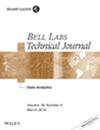Probabilistic radio-frequency fingerprinting and localization on the run
Q1 Engineering
引用次数: 58
Abstract
Indoor localization is a key enabler for pervasive computing and network optimization. Wireless local area network (WLAN) positioning systems typically rely on fingerprints of received signal strength (RSS) measures from access points. In this paper, we review approaches for modeling full distributions of Wi-Fi signals, including Bayesian graphical models, smoothing, compressive sensing, and random field differentiation and concentrate on the Kullback-Leibler divergence metric that compares multivariate RSS distributions. We provide theoretical insights on the required spatial density of fingerprints and on the number of samples necessary, during tracking or during signal map building, to differentiate among signal distributions and to provide accurate location estimates. We validate our methods on contrasting datasets where we obtain state-of-the-art localization results. Finally, we exploit datasets collected by a self-localizing mobile robot that continuously records Wi-Fi along with ground truth position, where we define increasingly denser fingerprint grids and study asymptotic localization accuracy. ® 2014 Alcatel-Lucent.概率射频指纹和定位在运行中
室内定位是普适计算和网络优化的关键推动者。无线局域网(WLAN)定位系统通常依赖于接入点接收信号强度(RSS)测量的指纹。在本文中,我们回顾了Wi-Fi信号全分布建模的方法,包括贝叶斯图形模型、平滑、压缩感知和随机场微分,并重点介绍了比较多变量RSS分布的Kullback-Leibler散度度量。我们提供了在跟踪或信号地图构建过程中所需的指纹空间密度和必要的样本数量的理论见解,以区分信号分布并提供准确的位置估计。我们在对比数据集上验证了我们的方法,我们获得了最先进的定位结果。最后,我们利用自定位移动机器人收集的数据集,该机器人连续记录Wi-Fi以及地面真实位置,我们定义了越来越密集的指纹网格,并研究了渐近定位精度。®2014阿尔卡特朗讯
本文章由计算机程序翻译,如有差异,请以英文原文为准。
求助全文
约1分钟内获得全文
求助全文
来源期刊

Bell Labs Technical Journal
工程技术-电信学
自引率
0.00%
发文量
0
审稿时长
6-12 weeks
期刊介绍:
The Bell Labs Technical Journal (BLTJ) highlights key research and development activities across Alcatel-Lucent — within Bell Labs, within the company’s CTO organizations, and in cross-functional projects and initiatives. It publishes papers and letters by Alcatel-Lucent researchers, scientists, and engineers and co-authors affiliated with universities, government and corporate research labs, and customer companies. Its aim is to promote progress in communications fields worldwide; Bell Labs innovations enable Alcatel-Lucent to deliver leading products, solutions, and services that meet customers’ mission critical needs.
 求助内容:
求助内容: 应助结果提醒方式:
应助结果提醒方式:


